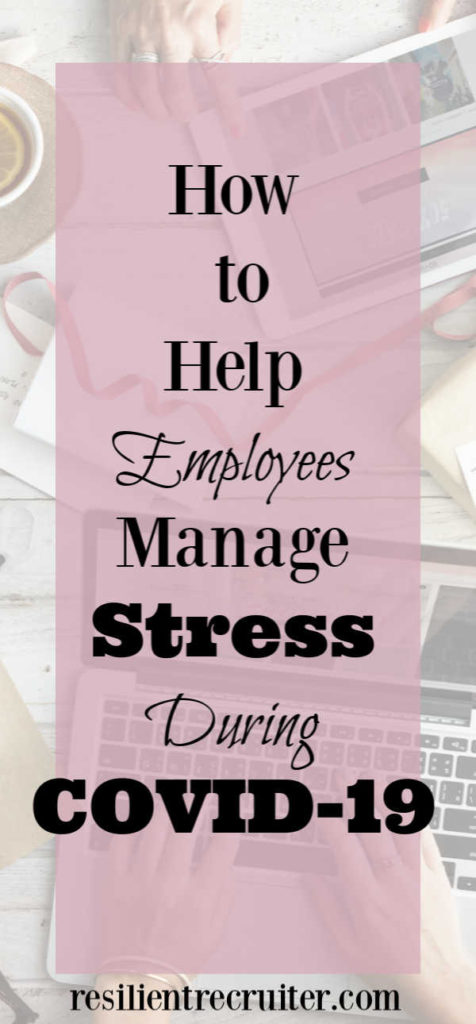As the coronavirus continues to dominate much of our news and impact every facet of our day to day lives, it can be difficult for employees to manage their stress and anxiety amid COVID-19. Managers and HR professionals can play an important role in helping employees cope with the added stress and uncertainties of the pandemic. In this article, we’ll help you to understand the stress that employees may be experiencing and provide stress management strategies and tools that can help all of us to get through this challenging time.
The difference between “good” and “bad” stress
Before we dive into suggestions on how to manage stress, let’s first clarify the type of stress we want to alleviate. The American Institute of Stress (AIS) points out the difference between “good stress” and “bad stress.” Good stress, or eustress, has a positive effect because it can feel exciting or fun, or it can help to drive our motivation to get something done. On the other hand, AIS notes that “bad stress” is commonly defined as “physical, mental, or emotional strain or tension” that leads to a feeling of distress.
It is the latter that we want to help employees alleviate amid the COVID-19 pandemic. This type of stress can lead to physical and mental health problems which can impact all aspects of one’s life – both personal and professional.
Stressors during COVID-19
You would be hard-pressed to find anyone not coping with some amount of stress directly related to the pandemic. Just a few of these stressors that employees could be dealing with include:
-
Uncertainty about the stability of their job and personal finances
-
Trying to adapt to new work arrangements through working remotely
-
Worry and fear about the safety of their work environment for those who are required to work on-site
-
Having to care for or homeschool children while balancing work demands
-
Adjusting to “shelter in place” routines that eliminate former options for fun and stress relief including entertainment, sports, travel, and simply gathering with friends or family.
All of these stressors are taking a toll on people, and it carries over into the workplace. Add to this list the growing health concerns for employees and their loved ones, and the worry they or someone they know will contract the virus and become ill. It’s more important than ever that people are able to acknowledge their feelings and reach out to one another to help alleviate concerns and provide support where possible.
How managers & HR professionals can help
Managers and human resources professionals can play an important role in both reducing the stress that employees feel and helping them to manage their stress levels during this time. A great place to start is with effective and frequent communication. Being transparent about what you do and don’t know, in addition to actions your company is taking to respond to the pandemic can help to lessen the scope of uncertainly and concern that your employees feel. For example, you could:
-
Express care and concern for their safety first and foremost, and encourage an open-door policy so that employees feel comfortable coming to you with questions and concerns.
-
Proactively communicate with employees and inform them of what you are doing to maintain a safe workplace.
-
Consider setting a regular schedule to send updates to staff on important issues such as impacts to the business, strategies and solutions being considered, workload, safety measures being taken, leave options, and other pertinent information.
-
Lean in! Touch base with your employees more than you might usually do whether they are physically at your workplace or working remotely. Make a point to speak to each person on your team a few times each week to see how they are doing and whether there is anything you can do to assist them.
-
If your company offers an Employee Assistance Program (EAP) or corporate wellness program, be sure to promote those resources as much as possible.
-
If your workplace is reducing hours or laying off staff, provide employees with information up-front on applying for unemployment benefits, discount services, or other programs being offered in your area.
While none of these activities is a “magic solution” to alleviating stress – your employees will see you taking action and your genuine concern will show through. They will appreciate you being a proactive resource, particularly during a time that is difficult for all of us.
How to approach someone who may be struggling
Managers are sometimes hesitant to approach an employee they feel may be struggling with depression or anxiety for fear of singling them out or infringing on their privacy. But if an employee is expressing feelings of fear, stress, or anxiety which is negatively impacting their performance or they’re behaving in a way that shows a decline in their health or mental well-being, it’s important that it be addressed. Working closely with an HR professional can ensure your inquiries don’t violate employee rights. The Americans with Disabilities Act (ADA) makes it illegal to discriminate on the basis of an employee’s disability. In addition, HIPAA prevents employers from directly obtaining health information on employees from a healthcare provider, unless the employee gives direct authorization.
Here’s a formula you can apply when addressing an employee showing signs of stress or anxiety:
-
Be Specific – Describe the incident or behavior which is problematic using objective, work-related terminology. Avoid assumptions or making accusations. Rather than saying, “You seem awfully tired lately and unfocused,” be more specific with something like, “You’ve been late three times this week and missed two important deadlines.”
-
Describe the Impact – Let the employee know how their actions or behavior is having a negative impact on the work, team, client, etc.
-
Problem-Solve Together – Ask for their input in addressing the situation and how to correct it. Use the opportunity to problem-solve with them and explore solutions. If through the course of the discussion they disclose they are suffering from a medical condition or feeling the need for professional help, engage your human resources department so they can manage the issue and explore options with the employee.
-
Clarify Expectations – Remind the employee of your expectations, both in performance and conduct, and allow them the opportunity to improve. If a pattern develops and you continue to see a decline, it may be necessary to take stronger actions.
Resources to manage stress during COVID-19
Sometimes when stress feels all-consuming, it can be hard to figure out how to move forward. Managers and HR professionals can also support employees by providing resources to help them manage and cope with stress. Recognizing that different methods work for different people, we will share several stress reduction options that you can share with employees – all of which can be woven into our professional and/or personal lives.
Three Methods for Coping with Stress
Researching the experts, here are three methods of coping with stress:
-
Eliminate stressors or change your response to them. Identify the stressors, and then try to reduce or eliminate them. If that is not possible, try to change how you respond to them. Particularly in times when the source of your stress feels out of your control, it can be empowering to leverage what you always have – your ability to control your response.
-
Use the coping resources available to you – both personal and relationship coping resources. If you can’t control the accumulation of stressors in your life, use your coping resources to help manage the stress. Your personal coping resources include your attitude, values, spiritual beliefs, nutrition, exercise, and sleep/rest.
-
Develop new coping resources. Identify and create additional coping resources, which will give you greater means to more effectively prevent and cope with stress. During this unprecedented time, it’s possible that you may experience much higher levels of stress than you typically do. It can help to be open to new ways of dealing with stress these days as you’re likely carrying a much heavier load.
Stress-Reducing Breathing Technique
We all were born with the appropriate breathing technique but quickly lose it due to day to day stress. Watch a baby – they breathe long deep breaths in through the nose and out the nose. Studies show that slowing down your breathing calms the nervous system, which in turn lowers blood pressure and heart rate, reduces stress hormone levels and increases energy levels. Therefore, the deep breathing we did when we were born is a highly effective tool against asthma, poor digestion, weight gain, sleeplessness, high blood pressure, heart disease, AND STRESS.
We suggest you try this as a way to calm your mind:
-
Sit in a chair with both feet on the floor with your shoulders back and your chin up.
-
Place your hands on your diaphragm so that you can feel the movement of your breathing.
-
Breathe in deeply through your nose filling your abdomen and chest with air from bottom to top like you are filling a balloon.
-
Exhale all the air out of your nose from top to bottom.
-
Repeat 20 times, even just 5 – 10 will help.
This is just one breathing technique of many. If this one doesn’t work for you, research other techniques until you find one that is comfortable and refreshing for you.
Low Impact Exercise
The main way to reduce physical stress is to release endorphins into the bloodstream which is done through exercise. Getting a 20-30 minute workout three to four days a week is critical to keep endorphins flowing and the heart pumping. The key is finding something you like to do. Many turn to Yoga and Pilates for a blend of stress relief and strength development. To optimize the effectiveness of exercise, it can be beneficial to start with deep breathing exercises (like the one provided above) first.
Some low impact exercises we like are:
Yoga Tree Pose (Benefits: focus, concentration, balance, strength, and stretching)
-
Stand straight with your hands at your sides balancing your weight evenly on both feet.
-
Begin to shift the weight over to the right foot, lifting the left foot off the floor.
-
Bend the left knee bringing the sole of the left foot high onto the inner right thigh.
-
Keep both hips squared towards the front.
-
Place your hands on your hips for balance. To advance, raise your hands up in front of you over your head.
-
Focus on something that doesn’t move to help you keep balance.
-
Hold for 30 – 60 seconds.
-
Repeat standing on the left foot.
-
For more challenge, try closing your eyes.
Yoga Plank (Benefits: endurance, core strengthening)
-
Lie on your stomach supporting yourself on your forearms
-
Lift your body parallel to the floor keeping your head/neck in line with your spine looking straight down at the floor
-
Hold this position for 30 – 60 seconds
-
For more challenge, lift yourself up on your arms so your shoulders are directly over your wrists.
Pilates Hundred (Benefits: strengthens the core)
-
Lie flat on the floor on your back.
-
Keeping your back flat on the floor, raise both your legs to a 90-degree angle and then lower back toward the floor to a challenging level without lifting your back off the floor.
-
Keeping your back flat on the floor, raise your head and shoulders off the floor.
-
Keeping arms extended, lift and lower them about two inches from the floor, breathing in on the lift and out on the lower.
-
Do this for 5 up-and-down beats. Repeat 10 times until you have done a “hundred.”
These are just a few of our favorites that can be done almost anywhere but are especially a great way to start your day or to take mental breaks throughout the day. Here are a few resources if you’d like to build your own routine:
-
YogaJournal.com – Yoga information & videos
-
PotentialsUnlimited.com – Guided meditation
-
About.com – Information about fitness, healthy eating, & weight loss
At the end of the day, the health and well-being of your employees is critical to the future of your business. According to the American Institute of Stress, stress-related healthcare and missed work cost employers $300 billion. It’s easy to see that employers will benefit from supporting their employees’ good physical and mental health. We hope that the suggestions and resources provided here will help you to strengthen your organization and reduce employee stress.
by Natalie Lemons
Natalie Lemons is the Founder and President of Resilience Group, LLC, and The Resilient Recruiter and Co-Founder of Need a New Gig. She specializes in the area of Executive Search and services a diverse group of national and international companies, focusing on mid to upper-level management searches in a variety of industries. For more articles like this, follow her blog. Resilient Recruiter is an Amazon Associate.
Navigate YOUR Career Path!

Get in on our newsletters, FREE products and content to make your job easier!



